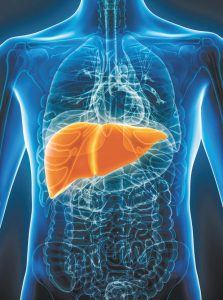By Dr. Eric Pearson, Chief Medical Officer, Vetirus Pharmaceuticals
 Your liver health may not be top of mind, but the minute it malfunctioned there wouldn’t be much else on your mind. Cirrhosis, in which liver cells are replaced with scar tissue, can prevent your liver from doing its critical jobs. So can nonalcoholic fatty liver disease, a fast-growing epidemic among the obese, which can lead to cirrhosis. If your liver stopped working, toxins would accumulate, you couldn’t digest your food and medications would never leave your body.
Your liver health may not be top of mind, but the minute it malfunctioned there wouldn’t be much else on your mind. Cirrhosis, in which liver cells are replaced with scar tissue, can prevent your liver from doing its critical jobs. So can nonalcoholic fatty liver disease, a fast-growing epidemic among the obese, which can lead to cirrhosis. If your liver stopped working, toxins would accumulate, you couldn’t digest your food and medications would never leave your body.
In fact — you can’t live a week without your liver.
“It’s an organ you could easily trash if you don’t take good care of it,” says Rohit Satoskar, MD, of the MedStar Georgetown Transplant Institute. “And once you trash it, it’s gone.” Your liver is about the size of a football and sits under your lower ribcage on the right side. It has several important things to do. It helps clean your blood by getting rid of harmful chemicals that your body makes. It makes a liquid called bile, which helps you break down fat from food. And it also stores sugar called glucose, which gives you a quick energy boost when you need it.
There’s nothing tricky about keeping your liver in good shape. It’s all about a healthy lifestyle, says Ray Chung, MD, medical director of the liver transplant program at Massachusetts General Hospital. “Taking care of your liver is far more about avoiding what’s bad than it is about eating or drinking things that are particularly nourishing to the liver,” he says.
The liver is your body’s largest internal organ, weighing between 3 and 5 pounds. Your liver is located on the right side of your upper body, below the lungs, taking up most of the space in your rib cage. The gallbladder, which stores bile made in the liver, is found tucked under your liver. Your liver is made up of two separate sections, or lobes: the larger right lobe and the smaller left lobe. These two lobes are separated by tissue which anchors your liver in place.
Unlike the lungs or heart, we cannot feel our liver working. Your liver is an incredibly hard-working organ with more than 500 different vital functions. Only your brain has more functions than the liver. Many of the liver’s functions are related to your metabolism. These metabolic functions allow you to convert food to energy, break down food to basic building blocks needed by your body and eliminate waste.
The liver…
• Produces bile
• Produces proteins for blood plasma
• Produces cholesterol and special proteins to help carry fats through the body
• Converts unused glucose into glycogen for storage
• Regulates levels of amino acids in blood
• Stores iron processed from hemoglobin
• Converts poisonous ammonia, made during digestion, to urea
• Processes drugs and other poisonous substances to your body
• Regulates blood clotting (or our ability to stop bleeding)
• Fights infections by making immune factors and
removing bacteria from the bloodstream
• Removes bilirubin from red blood cells
Non‐alcoholic fatty liver disease (NAFLD) is one of the most common chronic liver diseases. Astaxanthin, the active ingredient in Mitopak is a carotenoid, and beneficial effects of astaxanthin, including anti‐oxidative, anti‐inflammatory, and anti‐tumor activity, have been identified.
Studies have shown that most carotenes have anti-aging, free radical scavenging, antioxidant, and anti-cancer effects, and have been widely used in the fields of medicine, food, cosmetics, and feed. Astaxanthin is the only carotenoid to penetrate the blood-brain and retinal barriers. It is frequently used as an antioxidant to treat brain injury and cardiovascular diseases and has been extensively studied in clinical practice. In addition, astaxanthin has shown anti-cancer effects in many cancers, including liver cancer, colon cancer, bladder cancer, oral cancer, and leukemia. In addition, many animal experiments have proved that astaxanthin plays an important role in regulating sugar metabolism, improving immunity and improving motor function.
The Role of Astaxanthin in Liver Diseases
Astaxanthin has been used in the prevention and treatment of a variety of systemic diseases in vivo due to its various biological activities. In recent years, researchers have confirmed that astaxanthin plays an important role in preventing acute liver injury, alleviating insulin resistance and NAFLD, liver fibrosis and liver cancer.
Liver Fibrosis
Liver fibrosis is a key link in the deterioration of chronic liver diseases such as viral hepatitis and fatty liver. Without effective intervention, 75–80% of these diseases can develop into cirrhosis, which seriously endangers human health. The reversibility of these factors also provides an important research target for the reversal of hepatic fibrosis. The mechanism of liver fibrosis is complex, involving the regulation of histopathology, cytology, cytokines, and their molecular levels. Mitopak can potentially prevent and treat liver diseases by inhibiting inflammation and improving glycolipid metabolism at the mitochondrial level.
Vetirus Pharmaceuticals is based in Naples, Florida and London, England and are focused on searching the world for developing Natural Biologics to advance their mission of changing the way we age in both human and veterinary medicine with purity and precision.
MitoPak.com | 239-238-8456
 Central Florida Health and Wellness Magazine Health and Wellness Articles of the Villages
Central Florida Health and Wellness Magazine Health and Wellness Articles of the Villages



